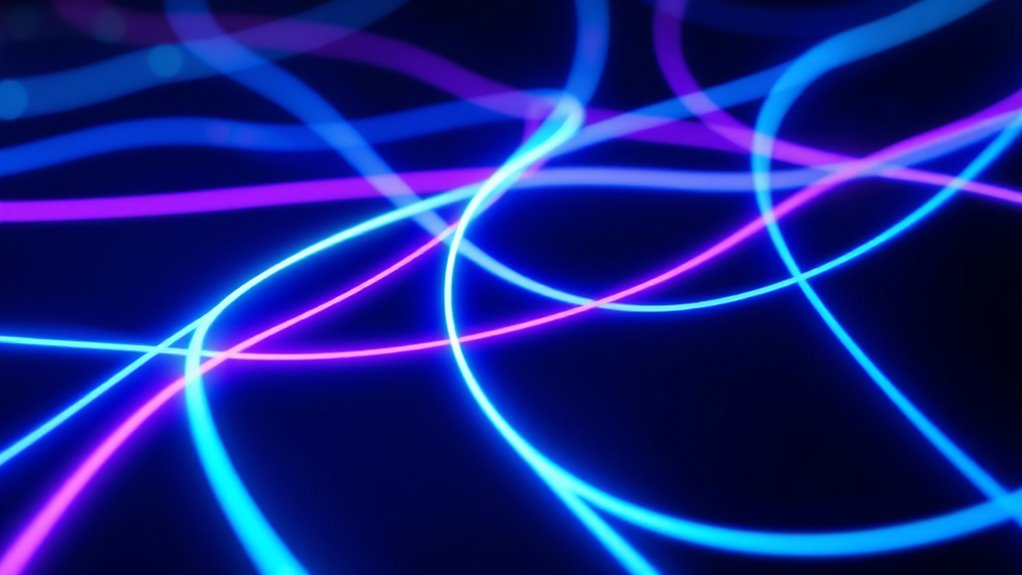When designing animated interfaces, prioritize responsiveness to guarantee smooth and immediate gesture reactions. Establish a clear visual hierarchy using motion to guide attention and simplify navigation. Combine these principles by using subtle, purposeful animations that reinforce interactions and highlight key features. Focus on timing, easing, and physics-based motion to create natural, engaging experiences. Mastering these concepts will help you craft interfaces that feel intuitive and compelling—you’ll discover even more tips as you explore further.
Key Takeaways
- Prioritize gesture responsiveness by ensuring smooth, immediate reactions to user inputs for a natural feel.
- Use visual hierarchy strategically to guide attention and emphasize key interface elements through motion.
- Combine motion with hierarchy to reinforce the significance of elements and create cohesive interactions.
- Incorporate physics-based motion and thoughtful timing to make animations feel realistic and purposeful.
- Design interactions that are controlled, fluid, and reinforce user confidence while reducing confusion.

Have you ever wondered what makes a motion design mesmerizing and effective? It all comes down to understanding how users interact with animated interfaces and how well those interactions guide and inform them. One key aspect is gesture responsiveness — how smoothly and accurately your motion responds to user inputs. When users swipe, tap, or drag, their gestures should trigger immediate, fluid reactions that feel natural and intuitive. If there’s any lag or awkward movement, it breaks the illusion of responsiveness and can frustrate users. Ensuring gesture responsiveness means paying close attention to timing, easing, and the physics of motion, making every interaction feel seamless. This responsiveness encourages users to engage more confidently, knowing their actions will produce the expected results without delay.
Alongside gesture responsiveness, establishing a clear visual hierarchy is essential for effective motion design. Visual hierarchy guides users’ attention to the most important elements on the screen and helps them understand the flow of information. You can achieve this by using motion strategically — animating primary buttons with more prominence or giving secondary elements subtler movements. When done well, motion helps direct focus naturally, reducing cognitive load and making navigation effortless. Think of visual hierarchy as a roadmap within your interface; motion acts as signposts that lead users through their journey, highlighting key features and de-emphasizing less critical details. This clarity ensures users grasp the structure of your interface quickly, making their experience more intuitive.
Combining gesture responsiveness with a well-designed visual hierarchy creates a harmonious user experience. When gestures are smoothly handled and motion reinforces the importance of elements, users feel more confident and engaged. For example, a subtle bounce or fade-in can indicate a successful action, reaffirming their control. Simultaneously, motion can emphasize hierarchy by animating headers or icons to draw attention where it’s needed most. Balancing these principles requires attention to timing, easing, and the overall flow of motion, ensuring that interactions feel natural and purposeful. When users feel in control and can easily interpret the interface’s structure, they’re more likely to stay engaged and appreciate the thoughtful design.
Frequently Asked Questions
How Can Motion Design Improve User Engagement?
Motion design boosts user engagement by making interactions more intuitive and enjoyable. You can use microinteractions to provide immediate feedback, keeping users informed and motivated. Incorporating visual storytelling through smooth animations guides users seamlessly, making the experience memorable. When done right, motion creates a dynamic interface that encourages exploration, increases satisfaction, and keeps users invested in your platform. This lively, visual approach transforms simple actions into engaging experiences.
What Tools Are Best for Creating Animated Interfaces?
You should consider tools like Adobe After Effects and Principle for creating animated interfaces because they streamline your animation workflows and offer robust features. Figma and Adobe XD are excellent prototyping tools that allow you to visualize interactions quickly, making your design process more efficient. These tools enable you to craft smooth, engaging animations, improving user experience and helping you iterate designs seamlessly.
How Does Motion Influence User Perception of a Brand?
Motion profoundly influences how you perceive a brand by enhancing recognition and creating emotional impact. When you experience smooth, purposeful animations, they make the brand more memorable, strengthening your connection. Effective motion guides your attention, builds trust, and evokes emotions that resonate with you. As a result, well-designed animations leave a lasting impression, making you more likely to recall and prefer that brand over others without even realizing why.
Are There Accessibility Considerations in Motion Design?
You should consider accessibility in motion design by prioritizing visual accessibility and addressing motion sensitivity. Use subtle animations, avoid rapid or excessive movements, and provide options to reduce motion for users with motion sensitivity. Ensuring animations don’t trigger discomfort helps create inclusive interfaces. Always test your designs with diverse users to identify and fix any accessibility issues, making your animated interfaces welcoming and usable for everyone.
How to Balance Aesthetics and Functionality in Motion Design?
Think of your interface as a dance, where aesthetics and functionality move in harmony. To balance them, prioritize visual harmony so animations enhance rather than distract, guiding user focus smoothly. Use subtle, purposeful motion that delights without overwhelming. This way, your design remains beautiful and intuitive, ensuring users enjoy a seamless experience. Keep your animations aligned with user goals, blending form and function effortlessly like a well-choreographed performance.
Conclusion
By embracing these motion design principles, you subtly guide users through your interface, making their experience smoother and more engaging. When you apply thoughtful motion, you gently steer attention and create a seamless flow that feels natural and inviting. Remember, the magic lies in the details—small, intentional movements that quietly enhance usability. Stay curious and keep experimenting; your interface will thank you with increased delight and a touch of elegance that users will appreciate.









